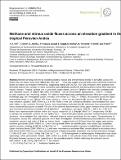Files in this item
Methane and nitrous oxide fluxes across an elevation gradient in the tropical Peruvian Andes
Item metadata
| dc.contributor.author | Teh, Y.A. | |
| dc.contributor.author | Diem, T. | |
| dc.contributor.author | Jones, S. | |
| dc.contributor.author | Huaraca Quispe, L.P. | |
| dc.contributor.author | Baggs, E. | |
| dc.contributor.author | Morley, N. | |
| dc.contributor.author | Richards, M. | |
| dc.contributor.author | Smith, P. | |
| dc.contributor.author | Meir, P. | |
| dc.date.accessioned | 2014-07-09T10:01:01Z | |
| dc.date.available | 2014-07-09T10:01:01Z | |
| dc.date.issued | 2014-04-25 | |
| dc.identifier | 130513184 | |
| dc.identifier | 0b3c7613-58a9-4ea2-8764-401dbf66534b | |
| dc.identifier | 84899473747 | |
| dc.identifier | 000335374200015 | |
| dc.identifier.citation | Teh , Y A , Diem , T , Jones , S , Huaraca Quispe , L P , Baggs , E , Morley , N , Richards , M , Smith , P & Meir , P 2014 , ' Methane and nitrous oxide fluxes across an elevation gradient in the tropical Peruvian Andes ' , Biogeosciences , vol. 11 , no. 8 , pp. 2325-2339 . https://doi.org/10.5194/bg-11-2325-2014 | en |
| dc.identifier.issn | 1726-4170 | |
| dc.identifier.uri | https://hdl.handle.net/10023/4977 | |
| dc.description | The authors acknowledge the agencies that funded this research; the UK Natural Environment Research Council (NERC; joint grant references NE/H006583, NE/H007849 and NE/H006753) and the Norwegian Agency for Development Cooperation (Norad; via a sub-contract to Yit Arn Teh managed by the Amazon Conservation Association). Pete Smith is a Royal Society Wolfson Research Merit Award holder and Patrick Meir is supported by an Australian Research Council Fellowship (FT110100457). | en |
| dc.description.abstract | Remote sensing and inverse modelling studies indicate that the tropics emit more CH4 and N2O than predicted by bottom-up emissions inventories, suggesting that terrestrial sources are stronger or more numerous than previously thought. Tropical uplands are a potentially large and important source of CH4 and N2O often overlooked by past empirical and modelling studies. To address this knowledge gap, we investigated spatial, temporal and environmental trends in soil CH4 and N2O fluxes across a long elevation gradient (600-3700 m a.s.l.) in the Kosñipata Valley, in the southern Peruvian Andes, that experiences seasonal fluctuations in rainfall. The aim of this work was to produce preliminary estimates of soil CH4 and N2O fluxes from representative habitats within this region, and to identify the proximate controls on soil CH4 and N2O dynamics. Area-weighted flux calculations indicated that ecosystems across this altitudinal gradient were both atmospheric sources and sinks of CH4 on an annual basis. Montane grasslands (3200–3700 m a.s.l.) were strong atmospheric sources, emitting 56.94 ± 7.81 kg CH4-C haĝ̂'1 yrĝ̂'1. Upper montane forest (2200-3200 m a.s.l.) and lower montane forest (1200-2200 m a.s.l.) were net atmospheric sinks (ĝ̂'2.99 ± 0.29 and ĝ̂'2.34 ± 0.29 kg CH4-C haĝ̂'1 yrĝ̂'1, respectively); while premontane forests (600-1200 m a.s.l.) fluctuated between source or sink depending on the season (wet season: 1.86 ± 1.50 kg CH4-C haĝ̂'1 yrĝ̂'1; dry season: ĝ̂'1.17 ± 0.40 kg CH4-C haĝ̂'1 yr−1). Analysis of spatial, temporal and environmental trends in soil CH4 flux across the study site suggest that soil redox was a dominant control on net soil CH4 flux. Soil CH4 emissions were greatest from habitats, landforms and during times of year when soils were suboxic, and soil CH4 efflux was inversely correlated with soil O2 concentration (Spearman's ρ Combining double low line −0.45,P< 0.0001) and positively correlated with water-filled pore space (Spearman's ρ Combining double low line 0.63,P<0.0001). Ecosystems across the region were net atmospheric N2O sources. Soil N2O fluxes declined with increasing elevation; area-weighted flux calculations indicated that N2O emissions from premontane forest, lower montane forest, upper montane forest and montane grasslands averaged 2.23 ± 1.31, 1.68 ± 0.44, 0.44 ± 0.47 and 0.15 ± 1.10 kg N2O-N haĝ̂'1 yrĝ̂'1, respectively. Soil N2O fluxes from premontane and lower montane forests exceeded prior model predictions for the region. Comprehensive investigation of field and laboratory data collected in this study suggest that soil N2O fluxes from this region were primarily driven by denitrification; that nitrate (NO3−) availability was the principal constraint on soil N2O fluxes; and that soil moisture and water-filled porosity played a secondary role in modulating N2O emissions. Any current and future changes in N management or anthropogenic N deposition may cause shifts in net soil N2O fluxes from these tropical montane ecosystems, further enhancing this emission source. | |
| dc.format.extent | 15 | |
| dc.format.extent | 1753217 | |
| dc.language.iso | eng | |
| dc.relation.ispartof | Biogeosciences | en |
| dc.subject | G Geography (General) | en |
| dc.subject | SDG 15 - Life on Land | en |
| dc.subject.lcc | G1 | en |
| dc.title | Methane and nitrous oxide fluxes across an elevation gradient in the tropical Peruvian Andes | en |
| dc.type | Journal article | en |
| dc.contributor.sponsor | NERC | en |
| dc.contributor.institution | University of St Andrews. Geography & Sustainable Development | en |
| dc.contributor.institution | University of St Andrews. Earth and Environmental Sciences | en |
| dc.contributor.institution | University of St Andrews. School of Biology | en |
| dc.contributor.institution | University of St Andrews. School of Management | en |
| dc.identifier.doi | 10.5194/bg-11-2325-2014 | |
| dc.description.status | Peer reviewed | en |
| dc.identifier.url | http://www.biogeosciences.net/11/2325/2014/ | en |
| dc.identifier.grantnumber | NE/H006583/1 | en |
This item appears in the following Collection(s)
Items in the St Andrews Research Repository are protected by copyright, with all rights reserved, unless otherwise indicated.

